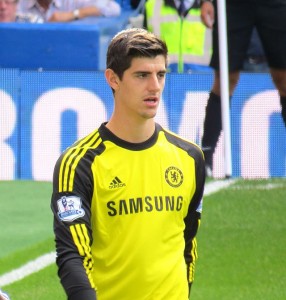The Heading Arms Race: Is unilateral disarmament the answer?
 “Someone has to be first; someone has to lead the way. Let’s just adopt a club policy: No heading and no teaching heading, until they are 14 years old.”
“Someone has to be first; someone has to lead the way. Let’s just adopt a club policy: No heading and no teaching heading, until they are 14 years old.”
This was the proposal the coach brought to the parents and it was roundly defeated. Hemming and hawing, the parents said, “We don’t want to be first. Let someone else lead the way.”
Yes, unilateral disarmament can be dangerous and is often unwise. Hey, let them make the first move; then we’ll follow suit. This is what I see in the concussion conversation, and it’s perfectly expressed in the chasm between policy and practice.

It’s one thing for a committee to recommend a rule change. It’s something else again to adopt it with your own kids, especially when others who seek a competitive advantage may not.
The professional soccer ranks, moving at glacial pace, are starting to come around on this issue, but only slowly and very painfully. The newswires are alive with yet another incredible mismanagement of a head injury situation. This time, the loser was Chelsea FC goalkeeper Thibaut Courtois.
His head met the knee of a charging Alexis Sanchez in the 10th minute of Chelsea’s English Premier League victory over Arsenal on Saturday, leaving Courtois apparently out cold on the pitch. A quick (only three minutes allowed under new policy) medical evaluation apparently found him fit to play, only to have them rush him to hospital in the 24th minute when he took a knee and appeared to be bleeding from the ear.
Scary? Yes. Let’s note that this was not a heading incident; it was head to knee, as seems the common circumstance in these serious injuries at the pro level, where goalkeepers using their hands at body level put their heads at risk. Perhaps there is a rule change that could offer protection here?
There’s no denying that unfortunate and perhaps reckless injuries continue to occur. The knee-jerk response in youth soccer circles is to host policy meetings and, pressured to act, recommend prohibiting heading and heading instruction before players are 14 years old. Is this the answer? I’m not so sure.
+READ: Dr. Wendy LeBolt: Dangerous headers are just stupid
Establishing a policy would make us all feel better — about ourselves. We like to have rules and concrete limits so we can say we are acting according to the rules. This, in our litigious society, is an unfortunate necessity. The actions being taken across the country are in response to this very pressure.
Well and good. Unless we think that by voting to prohibit heading under 14 we imagine we have done all we can to keep our children safe. This is far from true.
Drawing a line in the 14-year-old gray matter and washing our hands of the subject may actually be an irresponsible approach, because it may pose an even greater danger which needs to be taken into account. Researchers, sport medicine docs and policy makers studying rule changes designed to reduce head injury in a variety of sports have shown that, whatever the age at which rule changes to allow contact or collision are re-introduced, injury rates will spike at that age.
In other words, by drawing the line at 14, we’re setting up our 14-year-olds — the ones heading into high school play against 18-year-olds, the ones entering showcase play perhaps for the first time, the ones perhaps with the fastest-growing brains under the accelerating influence of hormones — to be the population with the spike in injury rates.
Is this what we intend? No. But research says that’s what happens when we draw a line in the sand, or in this case, the gray matter.
+ READ: LeBolt: We have a broken system when it comes to dealing with head injuries
So, while I roundly applaud coaches with the courage of conviction to act firmly on the behalf of their youth players, I advise caution in considering making this kind of age-based decision. We do absolutely need to study the effect of our training and play and make age-appropriate modifications for our players. But what I have seen work best with players of all ages is training which uses gradually increasing age-appropriate demands with a disciplined timeline for learning and execution.
 Our bodies are designed to work this way. In sport-science-speak, it’s called “progressive overload.” We start with a reasonable expectation for specific performance and gradually increase the difficulty. The physiological magic is: All the body parts involved in the action respond with gradual compensation in response to the demand. (Meaning, a muscle asked to contract slightly harder than it’s used to will pull slightly harder on its bony attachments, and these attachments will respond by laying down more bony tissue to capably and specifically resist the increased resistance.)
Our bodies are designed to work this way. In sport-science-speak, it’s called “progressive overload.” We start with a reasonable expectation for specific performance and gradually increase the difficulty. The physiological magic is: All the body parts involved in the action respond with gradual compensation in response to the demand. (Meaning, a muscle asked to contract slightly harder than it’s used to will pull slightly harder on its bony attachments, and these attachments will respond by laying down more bony tissue to capably and specifically resist the increased resistance.)
It’s the way we’re made.
The key words here are slightly and gradual. Change thrown at us suddenly and with little preparation is setting us up for injury. Progressive resistance grows and develops us. When we design it with the game’s demands in mind, it’s a perfect match. (This is the principle behind Fit2Finish training which is detailed in my new book, “Fit2Finish, Keeping Your Soccer Players in the Game.” )
This is why I advise caution as we consider the “no heading under 14” policy. Not because I think we should be encouraging heading melees among our 9- and 10-year-old boys, but because adopting it may give us a false sense of security that, because we have a rule now, everything will be fine. From my vantage point, we will be far from fine, as the unfortunate circumstance of Mr. Courtois has demonstrated.
+ READ: LeBolt: Julie Foudy offers an alternative for our childrens’ soccer development
A reasonable and responsible approach has us addressing in our own clubs and on our own teams:
- Administrators: What is your club’s concussion safety policy?
- Technical and coaching directors: Are all teams aware of and applying that policy?
- Coaches and parents: What are you doing to prevent concussions among your players?
The first step for every club truly interested in reducing injuries among their players is to monitor and record the current rate of injuries and the circumstances under which they are occurring. How else are we going to know whether injury prevention protocols and policies have any effect at all?
It’s a bold step to monitor and record injury rates. That takes courage because it means admitting your “errors” and measuring the “change” necessary. But it’s the only way I see to institute change in policy and practice that will keep our young athletes safe. Someone has to be first.
If you’re that administrator, that TD, that coach or that parent, Fit2Finish would like to work with you.
SOCCERWIRE MARKETPLACE
- The St. James FC Travel Staff Coach - North (Loudoun) & South (Fairfax)
- The St. James FC Girls Academy (GA) Head Coach - 2 teams
- The St James FC Boys Travel Tryouts
- OFFICIAL BAYERN MUNICH SUMMER CAMPS U.S.
- JOIN THE ALLIANCE!
- OFFICIAL FC BARCELONA CAMPS U.S.
- The Cup San Diego - Hosted by Legends FC
- Players Wanted - Undergraduate or Post-graduate
- Head Coach - South Region at The St. James FC
- Travel Coach - North Region at The St. James FC











